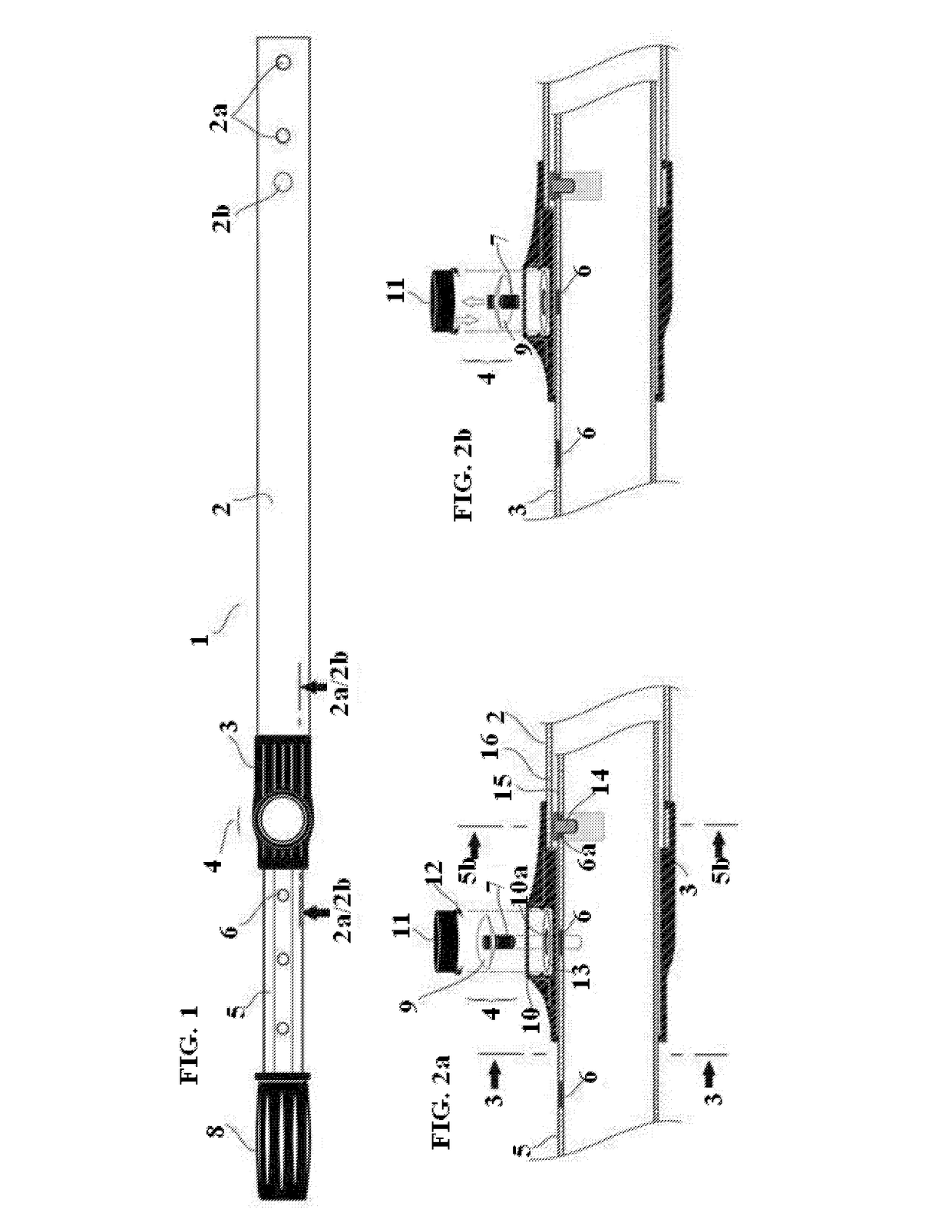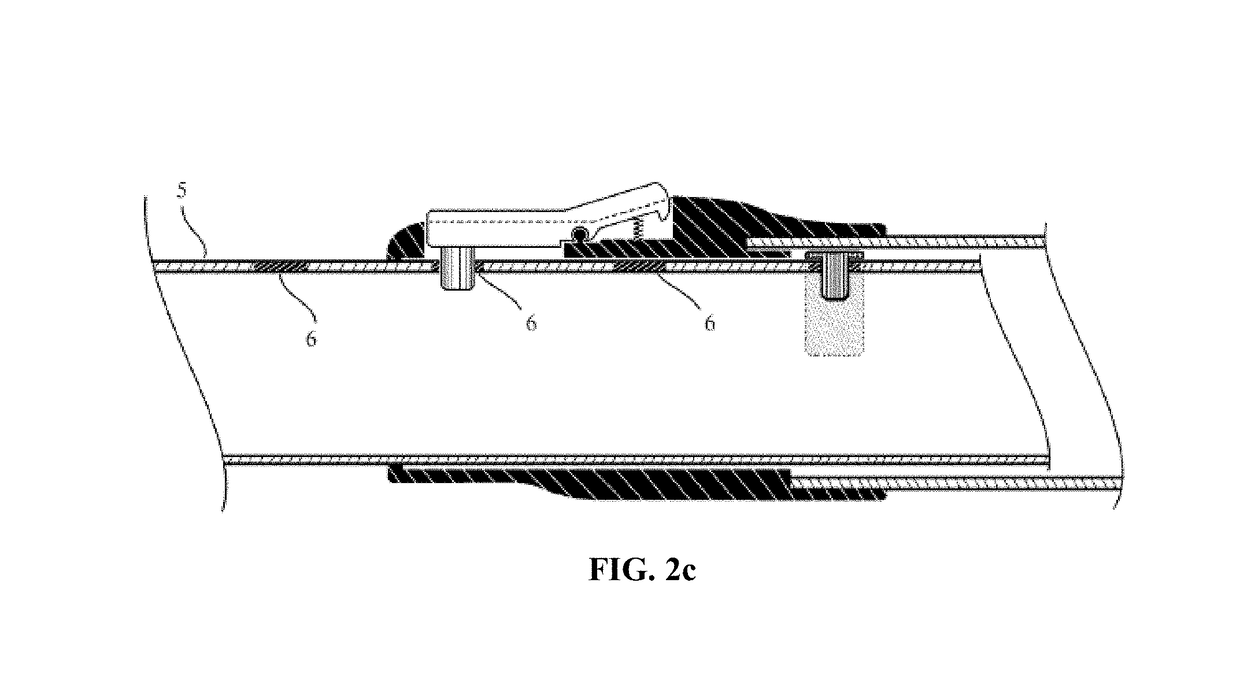Some of the problems with prior art extendable handles, however, are associated with the failure of the handles to perform adequately during use.
Sometimes manufacturers use harder woods to reduce such breakage; however, hard woods tend to weigh more than softer woods and consequently, make the tools heavier.
Handles made of
metal tubes are often used, but these may likewise be heavy or bend when under pressure.
It is also common for handles on shovels, rakes, brooms, etc. to be made from
synthetic materials such as plastic or fiberglass; such handles likewise may be heavy, lack strength or fail for other reasons.
However, handles of this length may easily sag in the middle between the user and the tool, and manufacturers have attempted to reduce sagging by increasing the
diameter and thickening the walls of the tubular sections.
In doing so, they use a greater amount of material (typically aluminum within the concrete industry) and, consequently, make the handles heavier and more difficult to work with.
However, when the user sufficiently further rotates the inner tube with respect to the outer tube, the inner tube's
cam element becomes misaligned with the profile of the inner walls of the outer / lower tube, and the
cam element applies a pressure against the inner walls of the outer tube and “locks” the inner tube in place within the outer tube.
Repeated use results in
wear and tear on the
cam and / or the inner walls of the outer tube, causing the contact surfaces of the cam and inner walls to become rough and / or out of round.
As a result, a cam may lose its ability to become misaligned with the inner walls of the tube and as a consequence the inner and outer tubes cannot be “locked” in place with respect to each other.
In this situation, the cam may also spontaneously align itself with the inner walls of the tube, thus permitting the tubes to readily slide past one another and causing the telepole to collapse / slip when pressure is applied to it during cleaning.
The tendency of the cam to spontaneously align with the inner walls may also result in tool failure and even poses the risk of the user falling into the pool if the telepole suddenly collapses while the user is applying pressure to it.
Further, prior art telepoles are prone to bending / becoming deformed during use due to the amount of pressure / weight applied to them by a user.
When this happens, the telepole's internal locking devices tend to jam in the areas where the tubes are out of round and / or not straight, resulting in complete failure of the telescopic feature of the pole.
In other words, and among other things, poles in this condition may not be extendable or adjustable in length.
Additionally, prior art external locking devices are subject to
wear and tear in prior art telepole devices.
Over time, the contacting surfaces can wear and / or become smooth and have less friction, which greatly reduces the ability of the compression ring to hold the inner tube in place.
The inner tube may also undesirably rotate when the telepole is in use, thus reducing the user's ability to maneuver the attached cleaning tools as desired.
Furthermore, telepoles having only an external locking device have the additional problem of water filling the inner tube during use since there is no cam to plug the end of the inner tube.
This can make the telepole very heavy and less maneuverable (as mentioned above, some water inside the tube(s), such as in the lower tube, can be helpful in using the tool, but too much water can be a substantial problem or inconvenience in using the tool).
Even further, new prior art telepoles having new compression rings have been known to undesirably permit inner tube rotating and / or sliding within the outer tube.
Attempts to remedy these known issues / problems have led to even more problems.
One such attempt increases the tightening force of the compression ring, but it can make the compression ring very difficult to loosen and painful to the user's hands to twist the compression ring either to tighten or loosen it.
The issues described above are common among prior art telepoles used to clean swimming pools and have led to the creation of telepoles with both internal and external locking devices, wherein either device may serve as a
backup for the other.
Over time, however, the areas of contact between the tubes become rough and develop friction, and the inner tube may become jammed within the outer tube.
Further, “telepoles” or extendable handles used in other applications are not necessarily suitable for use in swimming pools.
Furthermore, telepoles such as those used for window washing or painting would be especially impractical as the locking devices would be almost constantly under water, hindering the ease and ready adjustment of the telepole's length needed to clean a swimming pool.
Also, the locking devices of telepoles used in other applications are unsuitable for swimming pool cleaning applications.
For instance, external locking devices, such as those found on telepoles used for window washing, painting, or marine applications, tend to make pool cleaning difficult as they can easily catch on the edge of a pool or other objects when the telepole is being used, among other things.
For example, the Mr.
Long Arm Pole (shown in U.S. Pat. No. 5,220,707) has an external locking device with a button that activates a
detent mechanism to engage and release the inner tube of the telepole, but is not suitable in swimming pool applications for a number of reasons.
Further, the Mr.
Long Arm pole is sealed at both ends by a grip on the outer tube end and a threaded adapter on the inner tube end, and therefore is unable to accommodate the commonly-used V-clips of most swimming pool cleaning tools.
These openings in the inner tube would allow water to enter the pole when it is placed in a pool, etc. and make the telepole awkward and cumbersome to maneuver and control during use.
Additionally, since the grip is mounted on the end of the outer pole, the
detent mechanism would almost always be
underwater during use, and adjusting the pole's length would inconveniently require a user to withdraw some or all of the pole from the pool.
Therefore, bulky and / or angular levers that are commonly used on telepoles for other applications may obstruct a user's hand from easily passing back and forth over the lever and thus reduce a user's ability to effectively clean a swimming pool.
Furthermore, bumping a lever may cause pain or even injury to a user, especially if his or her hands have been wet for some time or exposed to pool chemicals.
Even further, bumping the lever with one's hands, an object, or even against the pool
deck may cause the lever to release unintentionally.
Still other problems occur with prior art as the inner tube may easily be overextended, especially among telepoles used for cleaning swimming pools.
As a result, the outer tube, along with the attached cleaning tool, can sink to the bottom of a pool and be difficult to retrieve.
Reassembling the telepole can be difficult and especially inconvenient if the inner tube has a cam locking device mounted on it since reassembly of the telepole requires that the cam's shoe, the inside tube and outside tube all must be aligned with each other for them to slide back together.
Additional problems arise with grips that fail to remain tightly attached to the end of the inside tube.
While grips are generally designed to fit very tightly, they still can be knocked off the end of the inside tube if that tube slides too far or too quickly into the outside tube.
 Login to View More
Login to View More  Login to View More
Login to View More 


